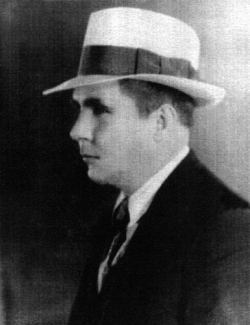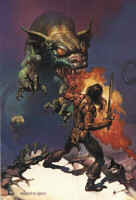
| ©Copyright 2002-2008 [Shawn Nacol] All rights reserved |
Robert Howard (1906-1936) originated such enduring heroic characters as Conan the Barbarian, Kull, and Solomon Kane, and published many of their adventures in the pages of Weird Tales. Howard's popularity during the magazine's heyday was great and continues today. His writing was by turns extraordinarily violent and sublimely beautiful. His prose was honest and forthright, yet he was capable of creating stunning, perfectly realized settings for his stories, and his poetry was among Weird Tales' loveliest. Howard killed himself at the age of 30 after learning of his mother's terminal illness. His suicide note, in its entirety, read, "All fled, all done, so lift me on the pyre; The feast is over, and the lamps expire."
THE FATHER OF CONAN By GLENN LORD, Literary Agent for the Estate of Robert E. Howard The future creator of Conan, Robert Ervin Howard, was born January 22, 1906, at Peaster, Texas, a tiny hamlet some forty-five miles southwest of Fort Worth. The father, a country physician, moved the little family the length and breadth of Texas over the next several years before finally settling at Cross Plains, a small town in Central Texas, in 1919. While yet in high school, young Robert began submitting short stories to the publications of the time. A chronological list of submissions in a letter to a friend, written circa 1929, indicated the first submission was "Bill Smalley and the Power of the Human Eye," rejected by both Western Story and Adventure in 1921. He finally made his first sale in 1924 when Weird Tales accepted "Spear and Fang," a short tale about Cro-Magnon and Neanderthal, for $18, payable on publication. Robert worked at a number of odd jobs after graduating from high school, for his writing brought in only meager income. He worked in a law office as a private secretary, packed a rod for a geologist, wrote up oil field news for various newspapers, as a public stenographer and finally in a drugstore. In the fall of 1926, discouraged with his lack of success at the writing game, he enrolled in a bookkeeping course at Howard Payne College in Brownwood. Before long, however, he was writing humorous pieces for the college newspaper, The Yellow Jacket, and once again submitting more stories to a number of potential markets, with some small success at the Weird Tales editorial offices. Among the list of rejected stories during this period, we may only conjecture what stories lay behind such titles as "The Valley of the Golden Web," "Sanctuary of the Sun," "The Crimson Line," "Vulture's Roost," "Windigo! Windigo!" and others; these manuscripts apparently no longer survive. Solomon Kane, the dour Puritan swordsman and redresser of wrongs, was the first of a number of continuing characters to see print (1928); the following year saw the advent of Kull, the Atlantean savage who eventually seized the throne of fabled Valusia in the Pre-Cataclysmic Age -i.e., before the sinking of Atlantis. Many of the Kull stories, however, failed to find a market until they were collected in book form in 1967.
The Great Depression, as might be expected, had its deleterious effect on the publishing industry. For a period of time, Weird Tales reduced its frequency of publication from monthly to bi-monthly; even after returning to a monthly schedule, it no longer was able to pay contributors on publication. Oriental Stories went to quarterly from bi-monthly appearance. And Flight Stories was suspended with the April 1932 issue and would not return to the newsstands until the Summer 1936 issue. Forced to seek new markets, Howard experimented with detective fiction with only negligible results, and would later admit it was not a genre for him. On the other hand, after some earlier failures, he found his niche in the western genre with the Paul Bunyanesque Breckinridge Elkins tales which ran in every issue of Action Stories from the initial story in early 1934 until after his death in 1936. So successful was this formula that two series of like nature had been accepted by rival publishers just a few months before his death. The November 1932 issue of Weird Tales introduced another popular character, Bran Mak Morn, the Pictish chieftain, whose battles with the encroaching Roman legions in Britain were very popular. The following month's issue introduced a character who would soon overshadow all his other heroes, and would be by far his most famous character: Conan the Cimmerian. This first Conan story, "The Phoenix on the Sword," was actually a rewrite of a rejected Kull story, "By This Axe I Rule!" Conan's world and career will probably be familiar to the readers of SAVAGE SWORD; he progressed from adventurer, thief, pirate and mercenary to the throne of Aquilonia in the Hyborian Age, a mythical period some 12,000 years ago between the sinking of Atlantis and the dawn of recorded history. Over the next four years, seventeen Conan stories appeared in Weird Tales, some lengthy enough to require serialization. Had the English publisher Pawling & Ness Ltd. not gone into receivership in 1934, "The Hour of the Dragon" would have been Howard's first book. (It was later serialized as a five-parter in Weird Tales, and has since been published in book form under the title Conan the Conqueror.) Howard was having an all-time high in sales by the beginning of 1936, with his work appearing regularly in Weird Tales and Action Stories, the Kirby O'Donnell and Francis X. Gordon (El Borak) adventure series appearing in Street & Smith's titles, and a new series of risqué tales under a pseudonym in Spicy Adventure Stories. But Howard's letters to correspondents indicated his growing worry over his mother's state of health. In 1935 Mrs. Howard had undergone surgery at the King's Daughters Hospital at Temple, Texas; she never fully regained her health, and from then on would require visits to regular medical facilities and intensive nursing care. On the morning of June 11, 1936, the attending nurse replied in the negative when Robert asked if his mother would ever emerge from her coma. He walked to his car, parked to the side rear of the home on the outskirts of Cross Plains, got in and fired a bullet into his brain. He died eight hours later; Mrs. Howard expired some thirty hours afterward. A double funeral was held, with interment in Greenleaf Memorial Cemetery at Brownwood.
|
|

 By 1930 Howard had become a regular in Weird Tales and had broken into Fight Stories with his humorous Sailor Steve Costigan yarns. Later in the year he began a series of historical adventure stories in Oriental Stories, a relatively short-lived companion title to Weird Tales.
By 1930 Howard had become a regular in Weird Tales and had broken into Fight Stories with his humorous Sailor Steve Costigan yarns. Later in the year he began a series of historical adventure stories in Oriental Stories, a relatively short-lived companion title to Weird Tales.